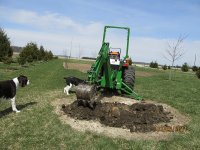If you have a choice of places to hook the top link to the tractor then it can be for two different reasons.
If it's a very basic tractor without draft control those top link connecting holes are all rigid to the back of the tractor tractor and the different positions are just for getting a decent geometry for the implement.
If you do have draft control - and it sounds like you do - then if you look closely at where the top link connects to the tractor you will see that that connection is actually a lever with a pivot and several choices of how far up the handle of the pivot you want to connect the top link. What that lever is doing is automatically activating the draft control valveto slighly raise the 3 pt. implement when it encounters a lot of ground resistance. You control how much ground resistance you want before activating the draft control by which location you choose. As am implement like a plow is pulled through the soil and hits a hard spot then it will try to rotate around the lower arms but is prevented from doing so by the upper link. That upper link is in compression when that happens and that compression is what the automatic draft control is sensing. The closer to the pivot point that you connect the top link then the more force it is going to take to activate the draft control and vice versa. From what your manual says, you do have draft control and the pivot point is lower down than the connection choices. So if you want the automatic draft control to be more sensitive to small changes as ithe implement is pulled through the soil that means you prefer that it just take a small change in the compressive force in the top link to be able to actuate that draft control valve. For that you need more leverage and that means you use the top hole which is farthest from the mount's pivot point. It works like a cheater bar. And for heavy implements in tough soil you usualy don't want so much leverage because you want the implement to stay at about the same depth in the soil regardless of what resistance it encounters. You are counting on using tractor horsepower to maintain a steady depth of pull through the hard spots instead of slightly raising the implement. Now there might be times when you want the opposite effect from what the manual says. If so, just change to a different mounting hole until the draft is doing what you want. You won't hurt anything with any of the choices. They are just there to give you choices between depth and traction.
HOWEVER: I have to say this...because it happened to me. Having draft control has one HUGE DANGER. And that is if you use a 3pt backhoe you MUST DISABLE THE DRAFT CONTROL! Otherwise the draft control will try to compensate for the bucket forces by raising the 3pt and attached backhoe....which then pinches the operator between the implement and the seat. Vey dangerous. People get killed every year forgetting to disable the draft control when using a 3 pt backhoe. I was lucky and was able to reach over my shoulder and switch off the ignition (Our old JD is gasoline tractor) and shut it down just as the backhoe controls rose up and pinned me to the back of the JD530s steel seat. Think about it.
Sometimes it's better to be lucky than smart. luck, rScotty

